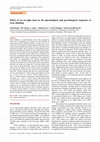Papers by Christoher Hodgson

The effect of creatine supplementation and sleep deprivation, with intermittent moderate-intensit... more The effect of creatine supplementation and sleep deprivation, with intermittent moderate-intensity exercise, on cognitive and psychomotor performance, mood state, effort and salivary concentrations of cortisol and melatonin were examined. Subjects were divided into a creatine supplementation group and a placebo group. They took 5 g of creatine monohydrate or a placebo, dependent on their group, four times a day for 7 days immediately prior to the experiment. They undertook tests examining central executive functioning, short-term memory, choice reaction time, balance, mood state and effort at baseline and following 18-, 24-and 36-h sleep deprivation, with moderate intermittent exercise. Saliva samples were taken prior to each set of tests. A group × time analysis of covariance, with baseline performance the covariate, showed that the creatine group performed significantly ( p b 0.05) better than the placebo group on the central executive task but only at 36 h. The creatine group demonstrated a significant ( p b 0.01) linear improvement in performance of the central executive task throughout the experiment, while the placebo group showed no significant effects. There were no significant differences between the groups for any of the other variables. A significant ( p b 0.001) main effect of time was found for the balance test with a linear improvement being registered. Cortisol concentrations on Day 1 were significantly ( p b 0.01) higher than on Day 2. Mood significantly ( p b 0.001) deteriorated up to 24 h with no change from 24 to 36 h. Effort at baseline was significantly ( p b 0.01) lower than in the other conditions. It was concluded that, during sleep deprivation with moderate-intensity exercise, creatine supplementation only affects performance of complex central executive tasks.
Wilderness & Environmental Medicine, 2015
To examine the effect of different levels of stress during three styles of rock climbing on subje... more To examine the effect of different levels of stress during three styles of rock climbing on subjective anxiety scores and cortisol levels.

Rock climbing is a popular but complex recreational activity with physical, cognitive and emotion... more Rock climbing is a popular but complex recreational activity with physical, cognitive and emotional demands. Many previous studies have tended to treat rock climbing as a purely physiological task. In an earlier study we were successful in linking the stress hormone cortisol to the subjective experiences of rock climbers. Higher cortisol concentrations were associated with higher levels of somatic anxiety. Cortisol concentration had a U-shaped profile in relation to both cognitive anxiety and self confidence rating with the lowest cortisol concentrations being observed when subjective emotional ratings were moderate and higher levels of cortisol being observed when either self confidence was high or cognitive anxiety was high. The aim of the present study was to link subjective anxiety ratings and cortisol to motor performance during rock climbing tasks with differing stress levels.

Journal of sports science & medicine, 2006
The performance advantage of active rather than passive recovery during subsequent trials for rep... more The performance advantage of active rather than passive recovery during subsequent trials for repeated high intensity short-term exercise is well documented. Research findings suggest that shorter periods of active recovery, than traditionally employed, can be prescribed and still retain performance benefits over passive recoveries in successive exercise trials. The aim of this study was to examine the benefits of a short duration active recovery for repeat climbing trials. Ten recreational climbers volunteered for the study. In this randomly assigned crossover study each climber completed five two-minute climbing trails before a two minute active or passive recovery. This was followed by a one and a half minute passive refocusing period for all climbers before the subsequent climbing trial. Heart rate was monitored continuously, RPE immediately post climbing and fingertip capillary blood samples collected during each refocusing phase. There was a non-significant difference between ...

Journal of sports science & medicine, 2008
Rock climbing is a multi-discipline activity that encompasses forms such as bouldering, top ropin... more Rock climbing is a multi-discipline activity that encompasses forms such as bouldering, top roping and lead climbing on natural and artificial climbing surfaces. A major focus of research has been explanation of physiological functioning. More recent research indicates that anxiety levels are elevated for less experienced climbers and in response to lead climbing ascents. Research regarding the demands of rock climbing has placed a lesser focus on the interaction of psychological and physiological factors. The objective of this study was to examine the effects of an on-sight lead climb on the physiological and psychological demands of the climb in comparison with a subsequent lead climb. Ten intermediate level climbers volunteered to complete the two climbing trials, on-sight lead climb (OSLC) and second lead climb (LC2). Climb time, lactate concentrations (baseline, pre climb, post climb and 15 min post climb), heart rate (1 min pre climb, peak HR, 1 min post climb and average clim...

Perceptual and Motor Skills, 2010
Expert performers in sports that include a high proportion of closed skills have often been found... more Expert performers in sports that include a high proportion of closed skills have often been found to score relatively high in field independence tests; a field-independent cognitive style may be advantageous for learning and performance of closed skills. The relationship between field dependence-independence (measured on a Portable Rod and Frame Test) and the acquisition of a kayak skill was examined. Undergraduates (6 men, 11 women; M age = 21.6 yr., SD = 3.2) who had no previous kayaking experience participated. Participants completed a structured teaching session (2 hr.) designed to develop three key subskills necessary for the kayak roll. Number of trials taken to consistently perform the underwater orientation and paddle movement subskills and duration of practice taken to develop the upper/lower body separation subskill as well as participants' ability to complete the roll were assessed. Field independence was associated with better performance of subskills and skill acquisition tests. Learners with greater field independence may have an advantage when acquiring sport skills that require cognitive restructuring and a strong reliance on kinesthetic and proprioceptive feedback.
Journal of Vocational Education & Training, 2000

European Journal of Sport Science, 2009
Rock climbing is a popular adventure sport for which there is a growing body of scientific knowle... more Rock climbing is a popular adventure sport for which there is a growing body of scientific knowledge. There is, however, a lack of sport-specific assessment tools to monitor performance. The aim of this study was to examine the potential of the rock-over climbing test (ROCT) as a measure of climbing performance. The ROCT was conducted on a climbaflex board and involved the climber making a rock-over move for which the height gained from lower to upper handhold was measured. Results indicated there was a significant relationship between scaled (to the height of the climber) ROCT scores and climbing ability (r00.67, P B0.0005). Regression modelling revealed that the ROCT explained 45% of the variance in scores between climbers. The ROCT differentiated between climber ability levels. Mean ROCT scores for novice, intermediate, advanced, and elite climbers were 59.5%, 71%, 82%, and 90% of participant height respectively. Results of analysis of variance revealed that these differences were significant (F 3,42 013.38, P B0.0005). Limits of agreement and intra-class correlation indicated that the ROCT is a reliable performance measure. Our findings suggest that the ROCT is a useful measure of climbing performance.
British Journal of Sports Medicine, 2009
Objectives: To examine how different safety rope protocols impact on subjective anxiety and self-... more Objectives: To examine how different safety rope protocols impact on subjective anxiety and self-confidence levels and plasma cortisol concentrations and the relationship between subjective states and cortisol during rock climbing. Methods: Participants (n = 12) were tested in three climbing conditions that were designed to invoke low, moderate and high physical and mental stress. Plasma cortisol concentrations were collected before and after climbing and participants reported subjective anxiety and self-confidence states for each climb. Results: Repeated measures analysis of variance showed significant differences between conditions for somatic anxiety (F 2, 22 = 7.74, p = 0.009), self-confidence (F 2,

Canadian Journal of Applied Physiology, 1994
Rock climbing is a popular adventure sport with an increasing research base. Early studies in the... more Rock climbing is a popular adventure sport with an increasing research base. Early studies in the field did not make comparisons of ascents using different styles of climbing. More recently, differences in the physiological responses for an onsight lead climb and subsequent lead climb have been reported. The purpose of the present study was to examine the effect of style of climb (lead climb or top rope climb) on the physiological and psychological responses to rock climbing. Nine intermediate climbers volunteered for, and completed, two randomly assigned climbing trials and a maximum oxygen uptake (VO 2max ) test on a separate occasion. The climbers ascended the same 6a (sport grade) climb for both trials. Before climbing, heart rate, perception of anxiety (Revised Competitive State Anxiety Inventory-2), and blood lactate concentration were measured. Climb time, heart rate, VO 2 , lactate concentrations, and task load (National Aeronautics and Space Administration Task Load Index) in response to each trial were also recorded. Results indicated significant differences (P B0.05) between the trials for climb time, blood lactate concentration immediately after and 15 min after climbing, and heart rate 1 min after climbing. During lead and top rope climbing, mean VO 2 and represented 44% and 42% of treadmill VO 2max and mean heart rate represented 81% and 77% of maximum heart rate, respectively. There were no significant differences in feelings of anxiety before either climb, although climbers reported the lead climb to be physically and mentally more demanding, requiring more effort and resulting in greater frustration (P B0.05) than the top rope climb.

Rock climbing is a popular but complex recreational activity with physical, cognitive and emotion... more Rock climbing is a popular but complex recreational activity with physical, cognitive and emotional demands. Many previous studies have tended to treat rock climbing as a purely physiological task. In an earlier study we were successful in linking the stress hormone cortisol to the subjective experiences of rock climbers. Higher cortisol concentrations were associated with higher levels of somatic anxiety. Cortisol concentration had a U-shaped profile in relation to both cognitive anxiety and self confidence rating with the lowest cortisol concentrations being observed when subjective emotional ratings were moderate and higher levels of cortisol being observed when either self confidence was high or cognitive anxiety was high. The aim of the present study was to link subjective anxiety ratings and cortisol to motor performance during rock climbing tasks with differing stress levels.







Uploads
Papers by Christoher Hodgson